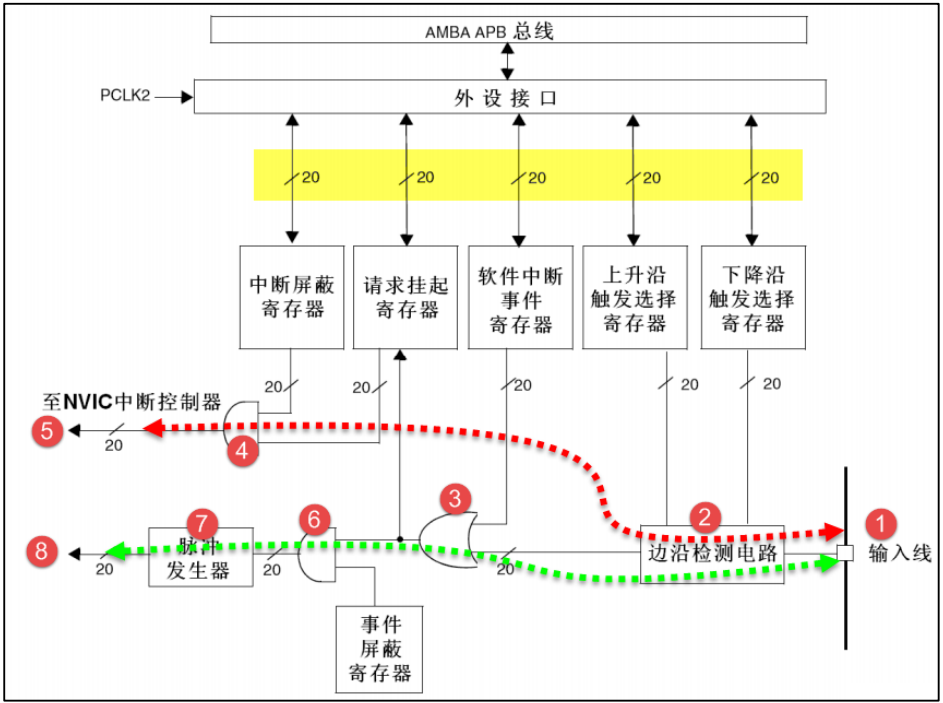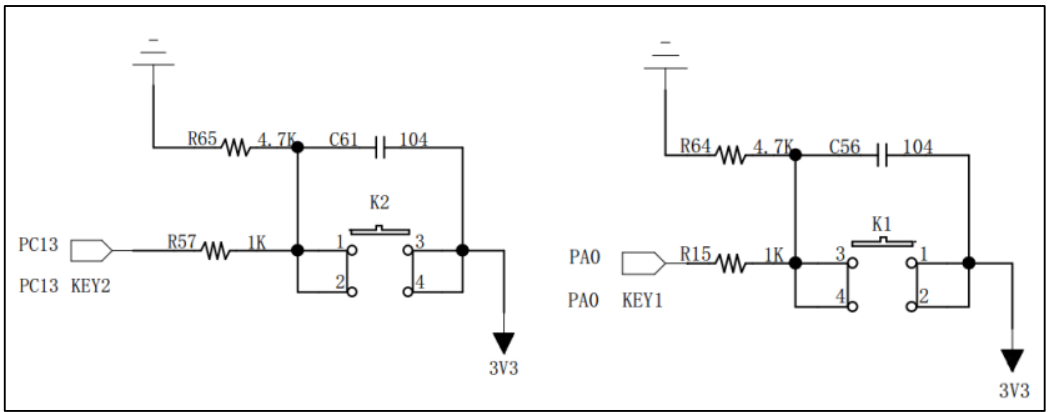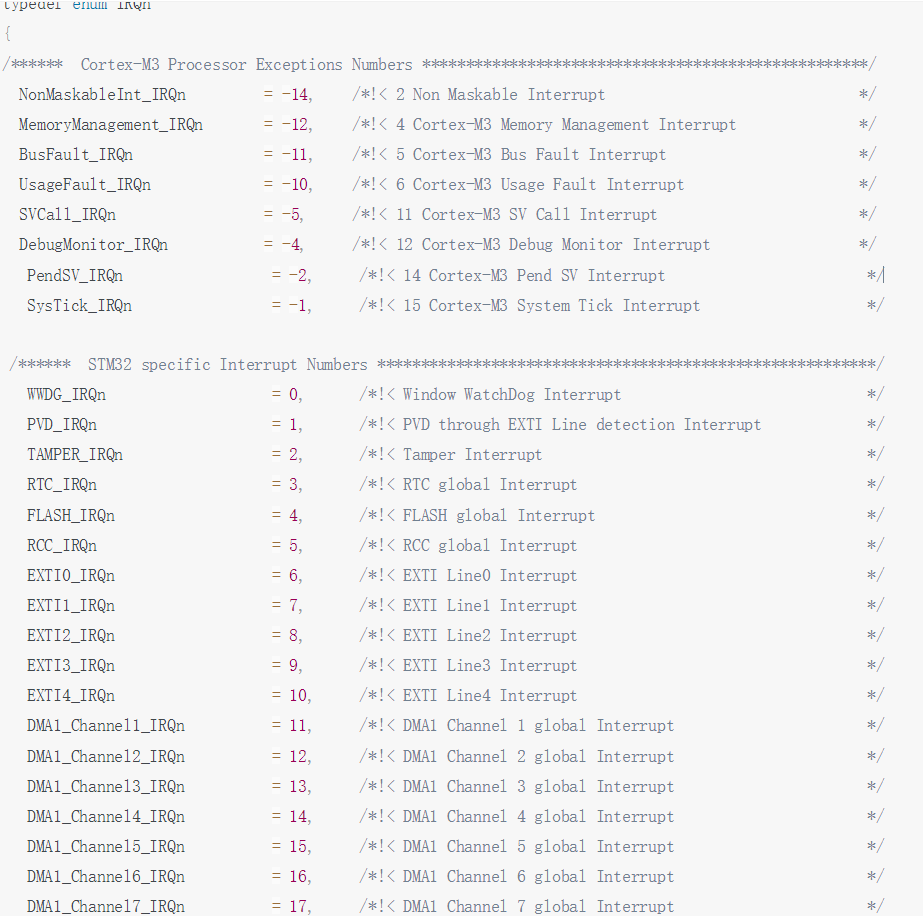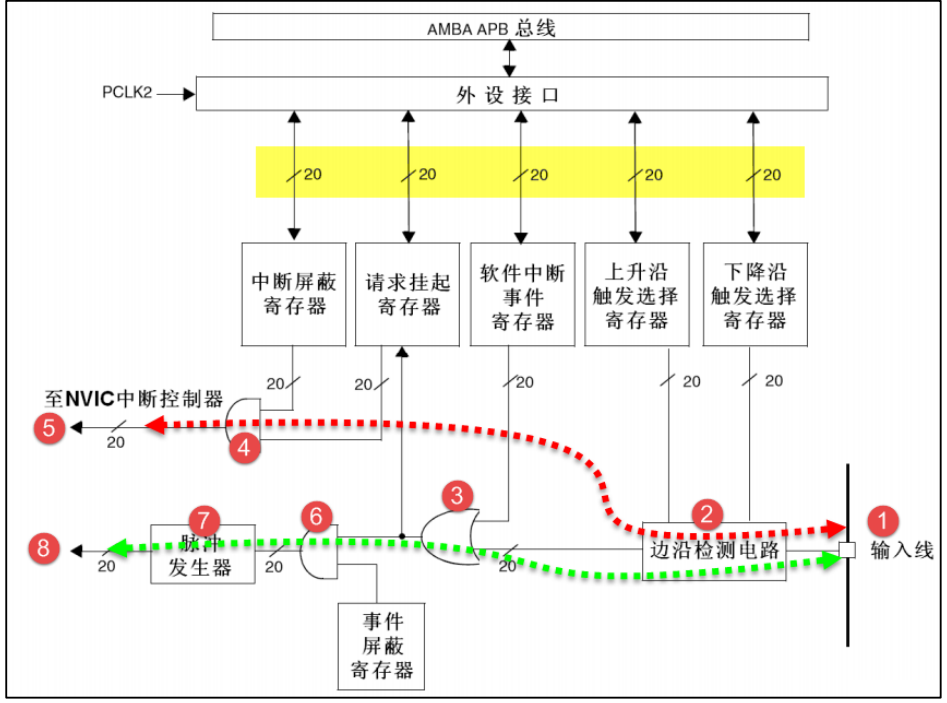This paper shows the identification operation of STM32 external interrupt EXTI
The content involves:
Identification of external interrupt EXTI
IO port input and output
External interrupt processing of key
External interrupt capture method
preface
Here we only explain the code of the core part. The setting of some variables and the inclusion of header files may not be involved. For the complete code, please refer to the supporting projects in this chapter. In order to make the project more organized, we store the codes related to LED light control independently, which is convenient for transplantation in the future. Create "RCC_book.c" and "RCC_book.h" files and the previous "Led_book.c" and "Led_book.h" files on the "project template": Git code
1, Programming points
External interrupt:1) Initialize the GPIO used to generate interrupts and enable an interrupt in the peripheral
2) Initialize EXTI
a: Initialize NVIC_InitTypeDef structure, configure interrupt priority grouping, set preemption priority and sub priority, and enable interrupt requests
b:NVIC_IROChannel: used to set the interrupt source
c:NVIC_IRQChannelPreemptionPriority: Preemption priority
d:NVIC_IRQChannelSubPriority
e:NVIC_IRQChannelCmd: interrupt ENABLE or DISABLE
3) Configure NVIC
4) Write interrupt service function
2, Use steps
1. Understand schematic diagram
,




The code is as follows:
: STM32F103ZET6 output port is valid for PB5 low level point
: STM32F103ZET6 Key detection pin is PA8
2. Create the header file exit of exi keyboard interrupt_ book. h
The code is as follows (example):
#ifndef __EXIT_BOOK_H_ #define __EXIT_BOOK_H_ #include "stm32f10x.h" #define _KEY_EXTI_IN_GPIO_Port GPIOA #define _KEY_EXTI_IN_GPIO_Pin GPIO_Pin_0 #define _EXTI_IN_GPIO_PortSource GPIO_PortSourceGPIOA #define _EXTI_IN_GPIO_PinSource GPIO_PinSource0 #define _EXTI_IN_EXTI_Line EXTI_Line0 #define _EXTI_IN_EXTI_Trigger EXTI_Trigger_Rising #define _EXTI_IN_GPIO_Clock RCC_APB2Periph_AFIO #define _EXTI_IN_EXTI_Mode EXTI_Mode_Interrupt #define _EXTI_IN_EXTI_LineCmd ENABLE #define _NVIC_IN_EXTI_IRQChannel EXTI0_IRQn #define _NVIC_IN_EXTI_IRQChannelCmd ENABLE #define _KEY2_EXTI_IN_GPIO_Port GPIOC #define _KEY2_EXTI_IN_GPIO_Pin GPIO_Pin_13 #define _EXTI_IN2_GPIO_PortSource GPIO_PortSourceGPIOC #define _EXTI_IN2_GPIO_PinSource GPIO_PinSource13 #define _EXTI_IN2_EXTI_Line EXTI_Line13 #define _EXTI_IN2_EXTI_Trigger EXTI_Trigger_Falling #define _EXTI_IN2_GPIO_Clock RCC_APB2Periph_AFIO #define _EXTI_IN2_EXTI_Mode EXTI_Mode_Interrupt #define _EXTI_IN2_EXTI_LineCmd ENABLE #define _NVIC_IN2_EXTI_IRQChannel EXTI15_10_IRQn #define _NVIC_IN2_EXTI_IRQChannelCmd ENABLE void fn_EXTI_GPIO_Config(void); void fn_NVIC_Config(void); void EXTI0_IRQHandler(void); #endif
3. Create the header file exit of exi keyboard interrupt_ book. c
The code is as follows (example):
#include "Exit_book.h"
#include "Led_book.h"
/**************************************************************
* @brief
* void fn_EXTI_GPIO_Config(void)
* @param
*
* #define _KEY_EXTI_IN_GPIO_Port GPIOA
* #define _KEY_EXTI_IN_GPIO_Pin GPIO_Pin_0
* #define _EXTI_IN_GPIO_PortSource GPIO_PortSourceGPIOA
* #define _EXTI_IN_GPIO_PinSource GPIO_PinSource0
* #define _EXTI_IN_EXTI_Line EXTI_Line0
* #define _EXTI_IN_EXTI_Trigger EXTI_Trigger_Rising
* #define _EXTI_IN_GPIO_Clock RCC_APB2Periph_AFIO
* #define _EXTI_IN_EXTI_Mode EXTI_Mode_Interrupt
* #define _EXTI_IN_EXTI_LineCmd ENABLE
*
* #define _KEY2_EXTI_IN_GPIO_Port GPIOC
* #define _KEY2_EXTI_IN_GPIO_Pin GPIO_Pin_13
* #define _EXTI_IN2_GPIO_PortSource GPIO_PortSourceGPIOC
* #define _EXTI_IN2_GPIO_PinSource GPIO_PinSource13
* #define _EXTI_IN2_EXTI_Line EXTI_Line13
* #define _EXTI_IN2_EXTI_Trigger EXTI_Trigger_Falling
* #define _EXTI_IN2_GPIO_Clock RCC_APB2Periph_AFIO
* #define _EXTI_IN2_EXTI_Mode EXTI_Mode_Interrupt
* #define _EXTI_IN2_EXTI_LineCmd ENABLE
* @retval
*************************************************************/
void fn_EXTI_GPIO_Config(void){
EXTI_InitTypeDef EXIT_InitStruck;
RCC_APB2PeriphClockCmd(_EXTI_IN_GPIO_Clock , ENABLE);
//Note: in addition to opening the port clock of GPIO, we also opened the clock of AFIO
GPIO_EXTILineConfig(_EXTI_IN_GPIO_PortSource | _EXTI_IN2_GPIO_PortSource , _EXTI_IN_GPIO_PinSource | _EXTI_IN2_GPIO_PinSource);
/* Select signal source of EXTI */
// GPIO_ The exilineconfig function is used to specify the input source of the interrupt / event line. It actually sets the external interrupt configuration
// Afio setting register_ Exicrx value. This function receives two parameters. The first parameter specifies the GPIO port source, and the second parameter specifies the GPIO port source
// The second parameter is to select the corresponding GPIO pin source number.
EXIT_InitStruck.EXTI_Line = _EXTI_IN_EXTI_Line ; /* Select signal source of EXTI */
EXIT_InitStruck.EXTI_Mode = _EXTI_IN_EXTI_Mode; /* EXTI Interrupt mode */
EXIT_InitStruck.EXTI_Trigger = _EXTI_IN_EXTI_Trigger ; /* Rising edge interrupt */
EXIT_InitStruck.EXTI_LineCmd = _EXTI_IN_EXTI_LineCmd; /* Enable interrupt */
EXTI_Init(&EXIT_InitStruck);
// EXTI initializes the configured variables
// fn_NVIC_Config();
// Call NVIC_ The configuration function completes the priority configuration of key 1 and key 2 and enables the channel to be interrupted
EXIT_InitStruck.EXTI_Line = _EXTI_IN2_EXTI_Line; /* Select signal source of EXTI */
EXIT_InitStruck.EXTI_Mode = _EXTI_IN2_EXTI_Mode; /* EXTI Interrupt mode */
EXIT_InitStruck.EXTI_Trigger = _EXTI_IN2_EXTI_Trigger; /* Falling edge interrupt */
EXIT_InitStruck.EXTI_LineCmd = _EXTI_IN_EXTI_LineCmd;/* Enable interrupt */
EXTI_Init(&EXIT_InitStruck);
fn_NVIC_Config();
}
/**************************************************************
* @brief
* void fn_NVIC_Config(void)
* @param
* #define _NVIC_IN_EXTI_IRQChannel EXTI0_IRQn
* #define _NVIC_IN_EXTI_IRQChannelCmd ENABLE
* #define _NVIC_IN2_EXTI_IRQChannel EXTI15_10_IRQn
* #define _NVIC_IN2_EXTI_IRQChannelCmd ENABLE
* @retval
*************************************************************/
void fn_NVIC_Config(void){
NVIC_InitTypeDef NVIC_InitStruct;
/* Configure NVIC as priority group 1 */
NVIC_PriorityGroupConfig(NVIC_PriorityGroup_1);
/* Configure interrupt source: */
NVIC_InitStruct.NVIC_IRQChannel = _NVIC_IN_EXTI_IRQChannel; //EXTI0_IRQn;
/* Configure preemption priority: 1 */
NVIC_InitStruct.NVIC_IRQChannelPreemptionPriority = 1;
/* Configure sub priority: 1 */
NVIC_InitStruct.NVIC_IRQChannelSubPriority = 1;
/* Enable interrupt channel */
NVIC_InitStruct.NVIC_IRQChannelCmd = _NVIC_IN_EXTI_IRQChannelCmd; //ENABLE
NVIC_Init(&NVIC_InitStruct);
/* Configure interrupt source: */
NVIC_InitStruct.NVIC_IRQChannel = _NVIC_IN2_EXTI_IRQChannel; //EXTI0_IRQn;
NVIC_Init(&NVIC_InitStruct);
}
/**************************************************************
* @brief
* void fn_NVIC_Config(void)
* @param
* #define _KEY_EXTI_IN_GPIO_Port GPIOA
* #define _KEY_EXTI_IN_GPIO_Pin GPIO_Pin_0
* @retval
*************************************************************/
void EXTI0_IRQHandler(void){
// EXTI_GetITStatus function is used to obtain the interrupt flag bit status of exti. If there is an interrupt occurrence function on exti line
//The number returns "SET", otherwise it returns "RESET". In fact, exti_ The getitstatus function reads
//EXTI_PR register value to judge the status of the exti line.
if(EXTI_GetITStatus(_EXTI_IN_EXTI_Line)!= RESET){
if(GPIO_ReadInputDataBit(_KEY_EXTI_IN_GPIO_Port, _KEY_EXTI_IN_GPIO_Pin)==1){
__LED_Change__;
}
}
EXTI_ClearITPendingBit(_EXTI_IN_EXTI_Line); // Important clear interrupt flag bit
}
void EXTI15_10_IRQHandler(void){
if(EXTI_GetITStatus(_EXTI_IN2_EXTI_Line)!= RESET){
if(GPIO_ReadInputDataBit(_KEY2_EXTI_IN_GPIO_Port, _KEY2_EXTI_IN_GPIO_Pin)==0){
__LED_Change__;
}
}
EXTI_ClearITPendingBit(_EXTI_IN2_EXTI_Line); // Important clear interrupt flag bit
}
4. Create the header file Key for Key collection_ book. h
The code is as follows (example):
#ifndef __KEY_BOOK_H_
#define __KEY_BOOK_H_
#include "stm32f10x.h"
#include "Led_book.h"
#define KEY_IN_GPIO_Port GPIOA
#define KEY_IN_GPIO_Clock RCC_APB2Periph_GPIOA
#define KEY_IN_GPIO_Pin GPIO_Pin_0
#define KEY_IN_GPIO_Pin_Bit 0
#define Key_IN_GPIO_Modle GPIO_Mode_IN_FLOATING / / floating input
#define KEY2_IN_GPIO_Port GPIOC
#define KEY2_IN_GPIO_Clock RCC_APB2Periph_GPIOC
#define KEY2_IN_GPIO_Pin GPIO_Pin_13
#define KEY2_IN_GPIO_Pin_Bit 13
#define Key2_IN_GPIO_Modle GPIO_Mode_IN_FLOATING / / floating input
typedef union {
struct{
unsigned char BIT0:1;unsigned char BIT1:1;unsigned char BIT2:1;unsigned char BIT3:1;
unsigned char BIT4:1;unsigned char BIT5:1;unsigned char BIT6:1;unsigned char BIT7:1;
//unsigned char BIT8:1;unsigned char BIT9:1;unsigned char BIT10:1;unsigned char BIT11:1;
//unsigned char BIT12:1;unsigned char BIT13:1;unsigned char BIT14:1;unsigned char BIT15:1;
}DATA_BIT;
uint8_t DATA_BYTE;
}Per_key_type;
extern volatile Per_key_type key_flag;
#define bkey_10ms key_flag.DATA_BIT.BIT0
#define bkey_judge key_flag.DATA_BIT.BIT1
#define bkey_judge_long key_flag.DATA_BIT.BIT2
#define bkey_Effect key_flag.DATA_BIT.BIT3
#define bkey_LongEffect key_flag.DATA_BIT.BIT4
#define bkey_Effect_Lose key_flag.DATA_BIT.BIT5
#define bkey_Effect_LLose key_flag.DATA_BIT.BIT6
void fn_Key_GPIO_Config( GPIO_TypeDef* _GPIO_x , uint32_t _GPIO_Clock , uint16_t _GPIO_Pin_x , GPIOMode_TypeDef _GPIOMode_TypeDef );
void fn_Key_Init(void);
void fn_key_judge(void);
void fn_key_Effect(void);
void fn_key_Check(void);
#endif
5. Create the header file Key for Key collection_ book. c
The code is as follows (example):
#include "Key_book.h"
volatile Per_key_type key_flag;
/**************************************************************
* @brief
* void fn_Key_GPIO_Config( GPIO_TypeDef* _GPIO_x , uint32_t _GPIO_Clock ,
* uint16_t _GPIO_Pin_x , GPIOMode_TypeDef _GPIOMode_TypeDef );
* @param
* #define KEY_IN_GPIO_Port GPIOA
* #define KEY_IN_GPIO_Clock RCC_APB2Periph_GPIOA
* #define KEY_IN_GPIO_Pin GPIO_Pin_0
* #define KEY_IN_GPIO_Pin_Bit 0
* #define Key_IN_GPIO_Modle GPIO_Mode_IN_FLOATING //Floating input
*
* #define KEY2_IN_GPIO_Port GPIOC
* #define KEY2_IN_GPIO_Clock RCC_APB2Periph_GPIOC
* #define KEY2_IN_GPIO_Pin GPIO_Pin_13
* #define KEY2_IN_GPIO_Pin_Bit 13
* #define Key2_IN_GPIO_Modle GPIO_Mode_IN_FLOATING //Floating input
* @retval
*************************************************************/
void fn_Key_GPIO_Config( GPIO_TypeDef* _GPIO_x , uint32_t _GPIO_Clock , uint16_t _GPIO_Pin_x , GPIOMode_TypeDef _GPIOMode_TypeDef ){
GPIO_InitTypeDef GPIO_InitStruct;
GPIO_InitStruct.GPIO_Mode = _GPIOMode_TypeDef;
GPIO_InitStruct.GPIO_Pin = _GPIO_Pin_x;
RCC_APB2PeriphClockCmd(_GPIO_Clock,ENABLE);
GPIO_Init(_GPIO_x , &GPIO_InitStruct);
}
/**************************************************************
* @brief
* void fn_Key_Init(void);
* @param
* @retval
*************************************************************/
void fn_Key_Init(void){
fn_Key_GPIO_Config(KEY_IN_GPIO_Port,KEY_IN_GPIO_Clock,KEY_IN_GPIO_Pin,Key_IN_GPIO_Modle);
fn_Key_GPIO_Config(KEY2_IN_GPIO_Port,KEY2_IN_GPIO_Clock,KEY2_IN_GPIO_Pin,Key2_IN_GPIO_Modle);
}
/************************************************************
* @brief
* void fn_key_judge(void);
* @param
* @retval
**************************************************************/
#define _LONG_key 30
static uint16_t count_key ;
void fn_key_judge(void){
if(!bkey_10ms){return;}
bkey_10ms = 0;
if(GPIO_ReadInputDataBit(KEY_IN_GPIO_Port,KEY_IN_GPIO_Pin)){
if(count_key++<3){return;}
if(!bkey_judge){
bkey_judge = 1;
bkey_Effect = 1;
}else{
if(count_key>_LONG_key){
bkey_judge_long = 1;
bkey_LongEffect = 1;
}
}
}
else{
count_key = 0;
if(bkey_judge){
bkey_judge = 0;
if(bkey_judge_long){
bkey_judge_long = 0;
bkey_Effect_LLose = 1;
}else{
bkey_judge_long = 0;
bkey_Effect_Lose = 1;
}
}else{
bkey_judge = 0;
}
}
}
/************************************************************
* @brief
* void fn_key_Effect(void);
* @param
* @retval
*************************************************************/
void fn_key_Effect(void){
if(bkey_Effect){
bkey_Effect = 0;
fn_LED_Corporate(LED_OUT_GPIO_Port,LED_OUT_GPIO_Pin,LED_Corporate_Toggle);
}
}
/**************************************************************
* @brief
* void fn_key_Check(void);
* @param
* @retval
*************************************************************/
void fn_key_Check(void){
fn_key_judge();
fn_key_Effect();
}
6. Use the previous LED output header file Led_book.h
The code is as follows (example):
#ifndef __LED_BOOK_H_
#define __LED_BOOK_H_
#include "stm32f10x.h"
#define LED_OUT_GPIO_Port GPIOB //GPIO Point
#define LED_OUT_GPIO_Clock RCC_APB2Periph_GPIOB //GPIO clock
#define LED_OUT_GPIO_Pin GPIO_Pin_5
#define LED_OUT_GPIO_Pin_Bit 5
#define LED_OUT_GPIO_Modle GPIO_Mode_Out_PP
typedef enum {
LED_Corporate_On = 1,
LED_Corporate_OFF = 2,
LED_Corporate_Toggle = 3,
} LED_Corporate_state_t;
void fn_LED_GPIO_Config(GPIO_TypeDef* _GPIO_x , uint32_t _GPIO_Clock ,\
uint16_t _GPIO_Pin_x , GPIOMode_TypeDef _GPIOMode_TypeDef);
void fn_Led_Init(void);
void fn_LED_Corporate(GPIO_TypeDef* _GPIO_x , uint16_t _GPIO_Pin_x , \
LED_Corporate_state_t _LED_Corporate_state_t );
#define __LED_Change__ fn_LED_Corporate(LED_OUT_GPIO_Port,LED_OUT_GPIO_Pin,LED_Corporate_Toggle)
#endif
7. Use the header file LED output by the previous Led_book.c
The code is as follows (example):
#include "Led_book.h"
/**************************************************************
* @brief
* void fn_LED_GPIO_Config(GPIO_TypeDef* _GPIO_x , uint32_t _GPIO_Clock ,
* uint16_t _GPIO_Pin_x , GPIOMode_TypeDef _GPIOMode_TypeDef);
* @param
* @retval
*************************************************************/
#define LED_GPIO_Speed GPIO_Speed_10MHz
void fn_LED_GPIO_Config(GPIO_TypeDef* _GPIO_x , uint32_t _GPIO_Clock ,uint16_t _GPIO_Pin_x , GPIOMode_TypeDef _GPIOMode_TypeDef){
GPIO_InitTypeDef GPIO_InitStruct;
GPIO_InitStruct.GPIO_Mode = _GPIOMode_TypeDef;
GPIO_InitStruct.GPIO_Pin = _GPIO_Pin_x;
GPIO_InitStruct.GPIO_Speed = LED_GPIO_Speed;
RCC_APB2PeriphClockCmd(_GPIO_Clock ,ENABLE);
GPIO_Init(_GPIO_x , &GPIO_InitStruct) ;
GPIO_SetBits(_GPIO_x,_GPIO_Pin_x);
}
/**************************************************************
* @brief
* void fn_Led_Init(void);
* @param
* @retval
*************************************************************/
void fn_Led_Init(void){
fn_LED_GPIO_Config (LED_OUT_GPIO_Port,LED_OUT_GPIO_Clock,LED_OUT_GPIO_Pin,LED_OUT_GPIO_Modle);
}
/**************************************************************
* @brief
* void fn_LED_Corporate(GPIO_TypeDef* _GPIO_x , uint16_t _GPIO_Pin_x ,
* LED_Corporate_state_t _LED_Corporate_state_t );
* @param
* @retval
*************************************************************/
void fn_LED_Corporate(GPIO_TypeDef* _GPIO_x , uint16_t _GPIO_Pin_x , LED_Corporate_state_t _LED_Corporate_state_t ){
switch(_LED_Corporate_state_t){
case LED_Corporate_On :
GPIO_SetBits(_GPIO_x,_GPIO_Pin_x);
break;
case LED_Corporate_OFF:
GPIO_ResetBits(_GPIO_x,_GPIO_Pin_x);
break;
case LED_Corporate_Toggle:
GPIO_ReadOutputDataBit(_GPIO_x,_GPIO_Pin_x)?GPIO_ResetBits(_GPIO_x,_GPIO_Pin_x):GPIO_SetBits(_GPIO_x,_GPIO_Pin_x);
break;
}
}
//practice
//fn_LED_GPIO_Config (LED_OUT_GPIO_Port,LED_OUT_GPIO_Clock,LED_OUT_GPIO_Pin,LED_OUT_GPIO_Modle);
// while(1){
// delay(10000);
// fn_LED_Corporate(LED_OUT_GPIO_Port,LED_OUT_GPIO_Pin,LED_Corporate_Toggle);
// }
8. Set up the main program of the Systicks Key output main c
The code is as follows (example):
/**
******************************************************************************
* @file GPIO/JTAG_Remap/main.c
* @author MCD Application Team
* @version V3.5.0
* @date 08-April-2011
* @brief Main program body
******************************************************************************
* @attention
*
*
******************************************************************************
*/
/* Includes ------------------------------------------------------------------*/
#include "stm32f10x.h"
#include "PROJ_book.h"
/* Private functions ---------------------------------------------------------*/
/**
* @brief Main program.
* @param None
* @retval None
*/
void delay(int x);
void fn_Main_Init(void);
int main(void)
{
fn_Led_Init();
fn_Key_Init();
fn_Main_Init();
fn_EXTI_GPIO_Config();
while(1){
// fn_key_Check();
delay(10000);
}
}
void fn_Main_Init(void){
uint16_t count_Init = 2;
while(count_Init-->0){
__LED_Change__;
fn_Systick_Delay(500,_Systick_ms);
__LED_Change__;
fn_Systick_Delay(100,_Systick_ms);
__LED_Change__;
fn_Systick_Delay(100,_Systick_ms);
__LED_Change__;
fn_Systick_Delay(500,_Systick_ms);
}
}
void delay(int x){
int y = 0xFFFFF;
while((x--)>0){
while((y--)>0){
__NOP();
__NOP();
__NOP();
__NOP();
__NOP();
}
}
}
/******************* (C) COPYRIGHT 2011 STMicroelectronics *****END OF FILE****/
www.firebbs.cn.
Reference notes.
_ STM32f103 interrupt and EXT
STM32 EXIT – LED program
STM32 EXIT – EXIT program
STM32 EXIT – Key program
STM32 RCC - main program
summary
EXTI(External interrupt/event controller)—External interrupt/Event controller, which manages 20 of the controller Interrupts/Event line. Each interrupt/Each event line corresponds to an edge detector, which can realize the rising edge of the input signal Detection and falling edge detection. EXTI Each interrupt can be implemented/The event line can be configured separately as Interrupt or event, and the properties of the trigger event.

EXTI The functional block diagram includes EXTI The core content, master the functional block diagram, right EXTI There is a whole
When programming, the idea is very clear. EXTI The functional block diagram is shown in Figure 18-1. In Figure 18-1 You can see that many people put a slash on the signal line and mark the word "20", which indicates that it is in the controller
There are 20 internal similar signal lines, which is similar to EXTI There are 20 interrupts in total/The event line is consistent. So we just
To understand the principle of one of them, you can know the principle of the other 19 lines
EXTI0 to EXTI15 be used for GPIO,Any one can be realized through programming control GPIO As EXTI Lose
Incoming source. From table 18-1 You know, EXTI0 Can pass AFIO External interrupt configuration register 1(AFIO_EXTICR1)of
EXTI0[3:0]Bit selection configuration is PA0,PB0,PC0,PD0,PE0,PF0,PG0,PH0 or
EXTI Detailed explanation of initialization structure
The standard library function establishes an initialization structure for each peripheral, such as EXTI_InitTypeDef,structural morphology
Member is used to set the working parameters of the peripheral, and the peripheral initializes the configuration function, such as EXTI_Init()Call, these settings
The parameter will set the corresponding register of the peripheral to achieve the purpose of configuring the working environment of the peripheral
typedef struct {
2 uint32_t EXTI_Line; // Interrupt / event line
3 EXTIMode_TypeDef EXTI_Mode; // EXTI mode
4 EXTITrigger_TypeDef EXTI_Trigger; // Trigger type
5 FunctionalState EXTI_LineCmd; // EXTI enable
6 } EXTI_InitTypeDef;
1. First, press the key and EXTI Macro definition uses the macro definition method to specify the configuration related to hardware circuit design, which is very useful for program transplantation or upgrade. In the macro definition above, we can only open GPIO In addition to the port clock, we also turned it on AFIO This is because of the configuration later EXTI The signal source needs to be used AFIO External interrupt control register AFIO_EXTICRx 2. Nested vector interrupt controller NVIC Configure, configure the priority of two interrupt software 3. EXTI Interrupt configuration 4. use GPIO_InitTypeDef and EXTI_InitTypeDef Structure defines two for GPIO and EXTI Initialization configuration variables. The two structures have been explained in detail before. use GPIO Must be turned on before GPIO Clock of port; be used EXTI Must be on AFIO Clock. call NVIC_Configuration Function to configure the key priority and enable the interrupt channel. As interrupt/Event input line GPIO It is configured as input mode, specifically floating input, and the state of the pin is completely determined by the external circuit. GPIO_EXTILineConfig Function to specify an interrupt/The input source of the event line, which actually sets the external interrupt configuration register AFIO_EXTICRx Value, the function receives two parameters, and the first parameter specifies GPIO Port source, the second parameter is the corresponding selection GPIO Pin source number. Our purpose is to generate interrupts and execute interrupt service functions, EXTI Select the interrupt mode, press key 1 to use the rising edge trigger mode and enable EXTI Line. Key 2 basically adopts the parameter configuration related to key 1, but it is changed to the falling edge trigger mode